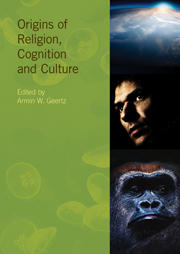Book contents
- Frontmatter
- Contents
- Contributors
- Introduction
- Part I EVOLUTIONARY SCENARIOS
- Part II COGNITIVE THEORIES
- 11 Cognition and meaning
- 12 Wittgenstein and the naturalness of religious belief
- 13 “Peekaboo!” and object permanence: on the play of concealment and appearance in cognition and religion
- 14 Yogācāra Buddhist views on the causal relation between language, cognition and the evolution of worlds
- 15 A resource model of religious cognition: motivation as a primary determinant for the complexity of supernatural agency representations
- 16 The recognition of religion: archaeological diagnosis and implicit theorizing
- 17 Religion and the extra-somatics of conceptual thought
- 18 Tools for thought: the ritual use of ordinary tools
- 19 Care of the soul: empathy in dualistic worldview
- 20 From corpse to concept: a cognitive theory on the ritualized treatment of dead bodies
- 21 Anthropomorphism in god concepts: the role of narrative
- Index
13 - “Peekaboo!” and object permanence: on the play of concealment and appearance in cognition and religion
from Part II - COGNITIVE THEORIES
- Frontmatter
- Contents
- Contributors
- Introduction
- Part I EVOLUTIONARY SCENARIOS
- Part II COGNITIVE THEORIES
- 11 Cognition and meaning
- 12 Wittgenstein and the naturalness of religious belief
- 13 “Peekaboo!” and object permanence: on the play of concealment and appearance in cognition and religion
- 14 Yogācāra Buddhist views on the causal relation between language, cognition and the evolution of worlds
- 15 A resource model of religious cognition: motivation as a primary determinant for the complexity of supernatural agency representations
- 16 The recognition of religion: archaeological diagnosis and implicit theorizing
- 17 Religion and the extra-somatics of conceptual thought
- 18 Tools for thought: the ritual use of ordinary tools
- 19 Care of the soul: empathy in dualistic worldview
- 20 From corpse to concept: a cognitive theory on the ritualized treatment of dead bodies
- 21 Anthropomorphism in god concepts: the role of narrative
- Index
Summary
Wet auto-da-fés and cognitive readings
From the past two hundred years of scholarly endeavour in the study of religion, we have all become acquainted with a profusion of innovative hypotheses concerning the origin and essence of religion. In the course of theoretical, methodological, even political, progress, most of these ideas were dismissed as unwarranted — historically, psychologically, ethically, gender-wise and so forth. However, academic turns and tides unfortunately often assume the rhetorical form of what could be called “wet auto-da-fés” (i.e. throwing a lot of babies out with the bathwater). Although I take cognitive studies to belong to one of the most promising approaches in the academic study of religion today, I am also a staunch believer that it is usually worthwhile to re-read and recycle its precursors. To be sure, not just for the sake of erudite namedrop-ping, genealogical awe, or an Olympic vista of alterations and continuities, but for the sake of genuine re-exploration. As Victor Turner put it:
It is not a theorist's whole system which so illuminates, but his scattered ideas, his flashes of insight taken out of systemic context and applied to scattered data. Such ideas have a virtue of their own and may generate new hypotheses. They even show how scattered facts may be systematically connected! Randomly distributed through some monstrous logical system, they resemble nourishing raisins in a cellular mass of inedible dough. The intuitions, not the tissue of logic connecting them, are what tend to survive.
(Turner 1974: 23)- Type
- Chapter
- Information
- Origins of Religion, Cognition and Culture , pp. 269 - 284Publisher: Acumen PublishingPrint publication year: 2013



